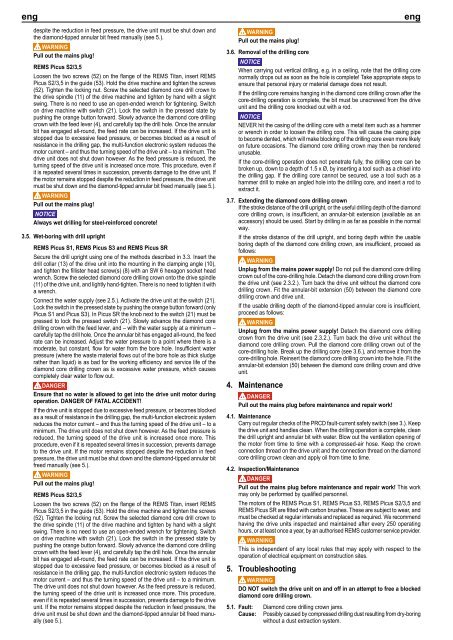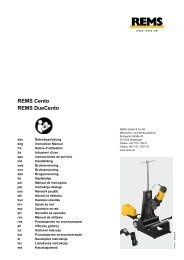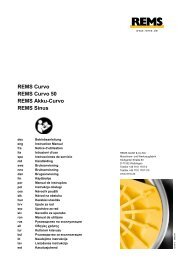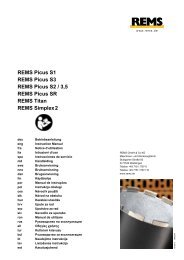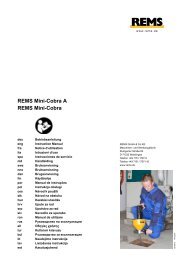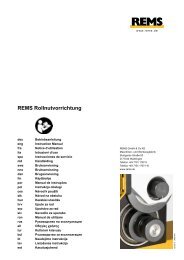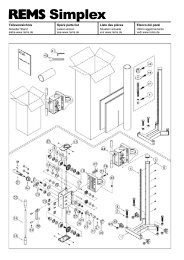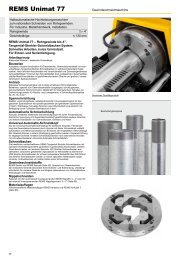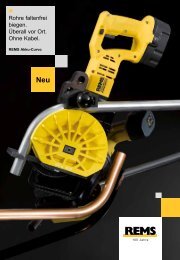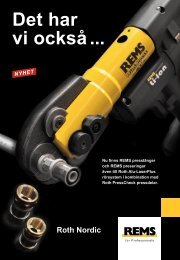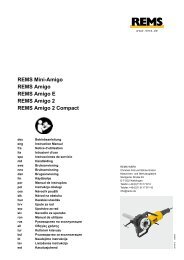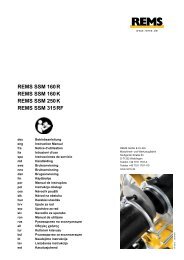REMS Picus S1 REMS Picus S3 REMS Picus S2 / 3,5 REMS Picus ...
REMS Picus S1 REMS Picus S3 REMS Picus S2 / 3,5 REMS Picus ...
REMS Picus S1 REMS Picus S3 REMS Picus S2 / 3,5 REMS Picus ...
Create successful ePaper yourself
Turn your PDF publications into a flip-book with our unique Google optimized e-Paper software.
eng eng<br />
despite the reduction in feed pressure, the drive unit must be shut down and<br />
the diamond-tipped annular bit freed manually (see 5.).<br />
WARNING<br />
Pull out the mains plug!<br />
<strong>REMS</strong> <strong>Picus</strong> <strong>S2</strong>/3,5<br />
Loosen the two screws (52) on the flange of the <strong>REMS</strong> Titan, insert <strong>REMS</strong><br />
<strong>Picus</strong> <strong>S2</strong>/3,5 in the guide (53). Hold the drive machine and tighten the screws<br />
(52). Tighten the locking nut. Screw the selected diamond core drill crown to<br />
the drive spindle (11) of the drive machine and tighten by hand with a slight<br />
swing. There is no need to use an open-ended wrench for tightening. Switch<br />
on drive machine with switch (21). Lock the switch in the pressed state by<br />
pushing the orange button forward. Slowly advance the diamond core drilling<br />
crown with the feed lever (4), and care fully tap the drill hole. Once the annular<br />
bit has engaged all-round, the feed rate can be increased. If the drive unit is<br />
stopped due to excessive feed pressure, or becomes blocked as a result of<br />
resistance in the drilling gap, the multi-function elec tronic system reduces the<br />
motor current – and thus the turning speed of the drive unit – to a minimum. The<br />
drive unit does not shut down how ever. As the feed pressure is reduced, the<br />
turning speed of the drive unit is increased once more. This procedure, even if<br />
it is repea ted several times in succession, prevents damage to the drive unit. If<br />
the motor remains stopped despite the reduction in feed pressure, the drive unit<br />
must be shut down and the diamond-tipped annular bit freed manually (see 5.).<br />
WARNING<br />
Pull out the mains plug!<br />
NOTICE<br />
Always wet drilling for steel-reinforced concrete!<br />
3.5. Wet-boring with drill upright<br />
<strong>REMS</strong> <strong>Picus</strong> <strong>S1</strong>, <strong>REMS</strong> <strong>Picus</strong> <strong>S3</strong> and <strong>REMS</strong> <strong>Picus</strong> SR<br />
Secure the drill upright using one of the methods described in 3.3. Insert the<br />
drill collar (13) of the drive unit into the mounting in the clamping angle (10),<br />
and tighten the fillister head screw(s) (8) with an SW 6 hexa gon socket head<br />
wrench. Screw the selected diamond core drilling crown onto the drive spindle<br />
(11) of the drive unit, and lightly hand-tighten. There is no need to tighten it with<br />
a wrench.<br />
Connect the water supply (see 2.5.). Activate the drive unit at the switch (21).<br />
Lock the switch in the pressed state by pushing the orange button forward (only<br />
<strong>Picus</strong> <strong>S1</strong> and <strong>Picus</strong> <strong>S3</strong>). In <strong>Picus</strong> SR the knob next to the switch (21) must be<br />
pressed to lock the pressed switch (21). Slowly advance the diamond core<br />
drilling crown with the feed lever, and – with the water supply at a minimum –<br />
carefully tap the drill hole. Once the annular bit has engaged all-round, the feed<br />
rate can be increased. Adjust the water pressure to a point where there is a<br />
moderate, but constant, flow for water from the bore hole. Insufficient water<br />
pressure (where the waste material flows out of the bore hole as thick sludge<br />
rather than liquid) is as bad for the working efficiency and service life of the<br />
diamond core drilling crown as is excessive water pressure, which causes<br />
completely clear water to flow out.<br />
DANGER<br />
Ensure that no water is allowed to get into the drive unit motor during<br />
operation. DANGER OF FATAL ACCIDENT!<br />
If the drive unit is stopped due to excessive feed pressure, or becomes blocked<br />
as a result of resistance in the drilling gap, the multi-function elec tronic system<br />
reduces the motor current – and thus the turning speed of the drive unit – to a<br />
minimum. The drive unit does not shut down how ever. As the feed pressure is<br />
reduced, the turning speed of the drive unit is increased once more. This<br />
procedure, even if it is repeated several times in succession, prevents damage<br />
to the drive unit. If the motor remains stopped despite the reduction in feed<br />
pressure, the drive unit must be shut down and the diamond-tipped annular bit<br />
freed manually (see 5.).<br />
WARNING<br />
Pull out the mains plug!<br />
<strong>REMS</strong> <strong>Picus</strong> <strong>S2</strong>/3,5<br />
Loosen the two screws (52) on the flange of the <strong>REMS</strong> Titan, insert <strong>REMS</strong><br />
<strong>Picus</strong> <strong>S2</strong>/3,5 in the guide (53). Hold the drive machine and tighten the screws<br />
(52). Tighten the locking nut. Screw the selected diamond core drill crown to<br />
the drive spindle (11) of the drive machine and tighten by hand with a slight<br />
swing. There is no need to use an open-ended wrench for tightening. Switch<br />
on drive machine with switch (21). Lock the switch in the pressed state by<br />
pushing the orange button forward. Slowly advance the diamond core drilling<br />
crown with the feed lever (4), and care fully tap the drill hole. Once the annular<br />
bit has engaged all-round, the feed rate can be increased. If the drive unit is<br />
stopped due to excessive feed pressure, or becomes blocked as a result of<br />
resistance in the drilling gap, the multi-function elec tronic system reduces the<br />
motor current – and thus the turning speed of the drive unit – to a minimum.<br />
The drive unit does not shut down how ever. As the feed pressure is reduced,<br />
the turning speed of the drive unit is increased once more. This procedure,<br />
even if it is repea ted several times in succession, prevents damage to the drive<br />
unit. If the motor remains stopped despite the reduction in feed pressure, the<br />
drive unit must be shut down and the diamond-tipped annular bit freed manually<br />
(see 5.).<br />
WARNING<br />
Pull out the mains plug!<br />
3.6. Removal of the drilling core<br />
NOTICE<br />
When carrying out vertical drilling, e.g. in a ceiling, note that the drilling core<br />
normally drops out as soon as the hole is complete! Take appropriate steps to<br />
ensure that personal injury or material damage does not result.<br />
If the drilling core remains hanging in the diamond core drilling crown after the<br />
core-drilling operation is complete, the bit must be unscrewed from the drive<br />
unit and the drilling core knocked out with a rod.<br />
NOTICE<br />
NEVER hit the casing of the drilling core with a metal item such as a hammer<br />
or wrench in order to loosen the drilling core. This will cause the casing pipe<br />
to become dented, which will make blocking of the drilling core even more likely<br />
on future occasions. The diamond core drilling crown may then be rendered<br />
unusable.<br />
If the core-drilling operation does not penetrate fully, the drilling core can be<br />
broken up, down to a depth of 1.5 x Ø, by inserting a tool such as a chisel into<br />
the drilling gap. If the drilling core cannot be secured, use a tool such as a<br />
hammer drill to make an angled hole into the drilling core, and insert a rod to<br />
extract it.<br />
3.7. Extending the diamond core drilling crown<br />
If the stroke distance of the drill upright, or the useful drilling depth of the diamond<br />
core drilling crown, is insufficient, an annular-bit extension (available as an<br />
accessory) should be used. Start by drilling in as far as possible in the normal<br />
way.<br />
If the stroke distance of the drill upright, and boring depth within the usa ble<br />
boring depth of the diamond core drilling crown, are insufficient, proceed as<br />
follows:<br />
WARNING<br />
Unplug from the mains power supply! Do not pull the diamond core drilling<br />
crown out of the core-drilling hole. Detach the diamond core drilling crown from<br />
the drive unit (see 2.3.2.). Turn back the drive unit without the diamond core<br />
drilling crown. Fit the annular-bit exten sion (50) between the diamond core<br />
drilling crown and drive unit.<br />
If the usable drilling depth of the diamond-tipped annular core is insufficient,<br />
proceed as follows:<br />
WARNING<br />
Unplug from the mains power supply! Detach the diamond core drilling<br />
crown from the drive unit (see 2.3.2.). Turn back the drive unit without the<br />
diamond core drilling crown. Pull the diamond core drilling crown out of the<br />
core-drilling hole. Break up the drilling core (see 3.6.), and remove it from the<br />
core-drilling hole. Reinsert the diamond core drilling crown into the hole. Fit the<br />
annular-bit extension (50) between the diamond core drilling crown and drive<br />
unit.<br />
4. Maintenance<br />
DANGER<br />
Pull out the mains plug before maintenance and repair work!<br />
4.1. Maintenance<br />
Carry out regular checks of the PRCD fault-current safety switch (see 3.). Keep<br />
the drive unit and handles clean. When the drilling operation is complete, clean<br />
the drill upright and annular bit with water. Blow out the ventilation opening of<br />
the motor from time to time with a compressed-air hose. Keep the crown<br />
connection thread on the drive unit and the connection thread on the diamond<br />
core drilling crown clean and apply oil from time to time.<br />
4.2. Inspection/Maintenance<br />
DANGER<br />
Pull out the mains plug before maintenance and repair work! This work<br />
may only be performed by qualified personnel.<br />
The motors of the <strong>REMS</strong> <strong>Picus</strong> <strong>S1</strong>, <strong>REMS</strong> <strong>Picus</strong> <strong>S3</strong>, <strong>REMS</strong> <strong>Picus</strong> <strong>S2</strong>/3,5 and<br />
<strong>REMS</strong> <strong>Picus</strong> SR are fitted with carbon brushes. These are subject to wear, and<br />
must be checked at regu lar intervals and replaced as required. We recommend<br />
having the drive units inspected and maintained after every 250 operating<br />
hours, or at least once a year, by an authorised <strong>REMS</strong> customer service provider.<br />
WARNING<br />
This is independent of any local rules that may apply with respect to the<br />
operation of electrical equipment on construction sites.<br />
5. Troubleshooting<br />
WARNING<br />
DO NOT switch the drive unit on and off in an attempt to free a blocked<br />
diamond core drilling crown.<br />
5.1. Fault: Diamond core drilling crown jams.<br />
Cause: Possibly caused by compressed drilling dust resulting from dry-boring<br />
without a dust extraction system.


